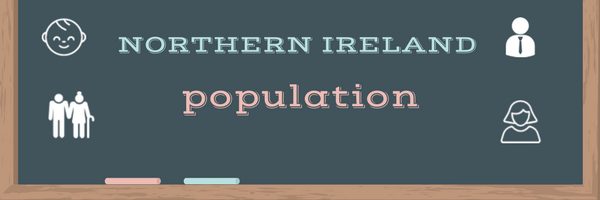
Northern Ireland is one of the countries in United Kingdom with population over 1.8 million. The country is the least in size among the countries in the UK. Northern Ireland is just 5.7 percent of the United Kingdom in terms of land size and the population of the nation is 2.9 percent of the whole UK.
Northern Ireland is the smaller of the two administrative units on the island of Ireland. The other counterpart is the Republic of Ireland and it is bigger than North Ireland in land size and population. Both countries separated in 1920 and Northern Ireland was formed in 1921. Despite this separation, the people of Northern Ireland still have a good relationship with people in the Republic of Ireland. The culture of the people in Republic of Ireland is practiced by some people in Northern Ireland until today.
Based on our research, Northern Ireland population will reach 1,941,076 by 1st July of 2024. We use first day of July each year due to Office for National Statistics (ONS) normally publishes the estimated population data for the same period. The calculation is based on the average growth rate of 0.54% over last 12 years since 2011. We believe using the recent years’ figures (see the table in next section) will make the estimation more accurate.
Population Growth of Northern Ireland
The population of Northern Ireland in the past twelve years can be used to estimate the population of the country in 2021. The growth rate of the country is very slow but consistent. The growth ranges from. 0.33% to 0.78%, adding around 6,100 to 14,500 people each year to the total population.
| Year | Population | Growth rate |
| 2011 | 1,810,863 | n/a |
| 2012 | 1,823,600 | 0.70% |
| 2013 | 1,829,700 | 0.33% |
| 2014 | 1,838,100 | 0.46% |
| 2015 | 1,851,600 | 0.73% |
| 2016 | 1,862,100 | 0.57% |
| 2017 | 1,876,600 | 0.78% |
| 2018 | 1,886,788 | 0.54% |
| 2019 | 1,897,893 | 0.59% |
| 2020 | 1,905,484 | 0.40% |
| 2021 | 1,914,232 | 0.46% |
| 2022 | 1,922,630 | 0.46% |
| 2023 | 1,930,734 | 0.42% |
Demographics of Northern Ireland
The major spoken language in Northern Ireland is English. Other languages are regional and they are Irish and Scots. Polish language is also spoken by some immigrants and it is the most frequent language spoken by immigrants in Northern Ireland. Other languages spoken by immigrants include Irish, Chinese, Slovak, Lithuanian, Portuguese, and Filipino etc.
Christianity is the dominant religion in Northern Ireland. A large percentage of the Christians in the country attend Roman Catholic Churches followed by Presbyterian Church in Ireland, Church of Ireland and Methodist Church in Ireland. Other religions are less than 1 percent of the total population while 10.1 percent of the population has no religion.
The ethnic groups in Northern Ireland are many. Whites represent 98.3 percent of the population, Asians are 1.06 percent of the population, and blacks are just 0.2 of the population.
Population Density of Northern Ireland
The population density of Northern Ireland is 133 people per square kilometer. This population density is approximately half of the United Kingdom. The population of Northern Ireland is twice denser than the population density of Republic Ireland. Majority of the population in the country resides in the Belfast Metropolitan Region.
Facts About Northern Ireland
- Northern Ireland was separated from Republic of Ireland in 1920 and Northern Ireland was created a year later.
- The country is the second most sparingly populated country in the UK after Scotland.
- Some prominent Sportsmen and Artist are from Northern Ireland.
- The Giant Causeway is a place with around 40,000 interlocking balsam columns.
- The national day of Northern Ireland is the famous St Patrick’s day, which is celebrated in many countries around the world including the United States of America.
- Guinness and Harp lager are popular Irish breweries.
- By 2014, the Catholic population in Belfast has risen to 49 percent, while the Protestant population has dropped to 42 percent, according to BBC News.
- On average, it rains 157 days a year in Belfast, less than Scotland, but more than Dublin.
References
The following links provide data for this topic:
- CNN: http://www.cnn.com
- Office for National Statistics: https://www.ons.gov.uk/
- BBC News: http://www.bbc.com/news
